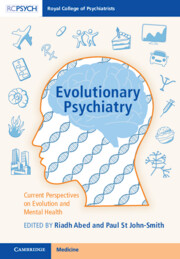Book contents
- Evolutionary Psychiatry
- Reviews
- Evolutionary Psychiatry
- Copyright page
- Contents
- Contributors
- Foreword
- Preface
- Chapter 1 Introduction to Evolutionary Psychiatry
- Chapter 2 The Biopsychosocial Model Advanced by Evolutionary Theory
- Chapter 3 Hominin Evolution I
- Chapter 4 Hominin Evolution II
- Chapter 5 Hunter-Gatherers, Mismatch and Mental Disorder
- Chapter 6 Why Do Mental Disorders Persist?
- Chapter 7 Anxiety Disorders in Evolutionary Perspective
- Chapter 8 Evolutionary Perspectives on Depression
- Chapter 9 On the Randomness of Suicide
- Chapter 10 Evolutionary Perspectives on Schizophrenia Spectrum Disorders
- Chapter 11 Evolutionary Perspectives on Eating Disorders
- Chapter 12 Substance Abuse and Evolution
- Chapter 13 The Social Function of Alcohol from an Evolutionary Perspective
- Chapter 14 Evolutionary Perspectives on Childhood Trauma
- Chapter 15 Evolutionary Perspectives on Neurodevelopmental Disorders
- Chapter 16 Maternal Negativity and Child Maltreatment
- Chapter 17 Alzheimer’s Disease as a Disease of Evolutionary Mismatch, with a Focus on Reproductive Life History
- Chapter 18 Psychopharmacology and Evolution
- Chapter 19 What the Evolutionary and Cognitive Sciences Offer the Sciences of Crime and Justice
- Chapter 20 Evolutionary Thinking and Clinical Care of Psychiatric Patients
- Index
- References
Chapter 4 - Hominin Evolution II
Sapiens, Masters of the Known Universe
Published online by Cambridge University Press: 08 September 2022
- Evolutionary Psychiatry
- Reviews
- Evolutionary Psychiatry
- Copyright page
- Contents
- Contributors
- Foreword
- Preface
- Chapter 1 Introduction to Evolutionary Psychiatry
- Chapter 2 The Biopsychosocial Model Advanced by Evolutionary Theory
- Chapter 3 Hominin Evolution I
- Chapter 4 Hominin Evolution II
- Chapter 5 Hunter-Gatherers, Mismatch and Mental Disorder
- Chapter 6 Why Do Mental Disorders Persist?
- Chapter 7 Anxiety Disorders in Evolutionary Perspective
- Chapter 8 Evolutionary Perspectives on Depression
- Chapter 9 On the Randomness of Suicide
- Chapter 10 Evolutionary Perspectives on Schizophrenia Spectrum Disorders
- Chapter 11 Evolutionary Perspectives on Eating Disorders
- Chapter 12 Substance Abuse and Evolution
- Chapter 13 The Social Function of Alcohol from an Evolutionary Perspective
- Chapter 14 Evolutionary Perspectives on Childhood Trauma
- Chapter 15 Evolutionary Perspectives on Neurodevelopmental Disorders
- Chapter 16 Maternal Negativity and Child Maltreatment
- Chapter 17 Alzheimer’s Disease as a Disease of Evolutionary Mismatch, with a Focus on Reproductive Life History
- Chapter 18 Psychopharmacology and Evolution
- Chapter 19 What the Evolutionary and Cognitive Sciences Offer the Sciences of Crime and Justice
- Chapter 20 Evolutionary Thinking and Clinical Care of Psychiatric Patients
- Index
- References
Summary
Our immediate ancestry remains uncertain at this time, but what is clear is that we are all African. This chapter will start with the current debates on the emergence of Homo sapiens and the changes we see in the subsequent 200,000 years in terms of our behavioural and cultural development. We have already shown that the ‘march of progress’ image – so culturally famous from t-shirts to posters – of a line of ever more upright and ‘civilised’ walking ape-to-man creatures is wrong. There has never been a single line, and we are not the apotheosis of evolution. A second myth is that ‘we evolved’ 200,000–300,000 years ago and since then have been static, with only technology progressing. However, humans have continued to change with time. The third conceit is the focus on ‘our’ move ‘out of Africa’ 50,000–60,000 years ago. This idea is problematic: it culturally assumes a non-African terminus as our destiny and is a very Eurocentric view of the world. It is true that a subpopulation of hunter-gather sapiens, most likely Yoruba peoples from around what is now Tanzania, left that continent at around that time, and from that group the rest of the world’s populations emerge. But this is to downplay the fact that for 80% of our species’ existence we have all been entirely African, and a genetically small subgroup left for the last 20% of that time. History is written by the ‘victors’, and much anthropology has been written by Western academia. In 2020, it was estimated that fewer than 2% of whole sequenced genomes have as yet come from Africa (Maxmen, ), and we lack ancient DNA from Africa greater than 15,000 years old (partially due to climactic reasons). However, the tide has begun to turn, and the next 10 years look very exciting in this regard.
Keywords
Information
- Type
- Chapter
- Information
- Evolutionary PsychiatryCurrent Perspectives on Evolution and Mental Health, pp. 50 - 63Publisher: Cambridge University PressPrint publication year: 2022
